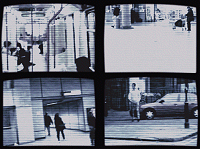Special Supplement: Securing the Campus
A Multi-Pronged Plan
As schools adopt new and varied technologies to protect the campus community, the need to look at security tools in terms of a comprehensive, layered, and integrated strategy, becomes clear.

IT’S ALMOST MIDNIGHT, and the moon’s barely a sliver. A young woman has just seen a movie with some friends, and she’s now trekking back to her dorm across the deserted campus. She’s actually enjoying the solitude until she spies a figure coming toward her. As he approaches, she tries to appear calm and unconcerned. The two pass, but within a minute the young woman hears footsteps behind her. Could the stranger have turned to follow her?
These days, on university campuses across the US, there are many ways this female student—or any campus member or visitor—might be protected in such a situation:
- If Campus Security officials are made aware of some danger— e.g., an intruder on campus—they can alert the student via a text or voice message on her cell phone.
- Even if she hadn’t been warned, the young woman could use a single button on her cell phone to contact Campus Security officers, and they would zero in on her location.
- Even if she couldn’t get to her phone, she could activate a special time-sensitive alert when she left her friends, and an alarm would be triggered after a predetermined time, indicating that she had not arrived at her destination.
- Even if the young woman didn’t own or have a cell phone on her person, “intelligent” surveillance would note the non-normative behavior of two individuals approaching each other (with one changing direction in a suspicious manner), thus signaling an alert.
- When the young woman arrived at her dorm, followed or not, she would spend no precious time fumbling with a key; she would press her thumb on a pad at the door and enter immediately.
SAFETY (AND VIDEO) TAKE OFF
James Black is senior security consultant for TRC Security. His firm implements campuswide security plans nationwide and particularly in California where, in the last five years, as a result of statewide bond measures, “there has been a significant shift toward funding for security,” says Black. Yet, even with those funds now more readily available, bells-and-whistles technology isn’t necessarily the order of the day. Black and his colleagues help campuses integrate “no-tech, low-tech, and high-tech” solutions to security needs, he explains, adding that whatiffing and planning are key. They ask questions such as, “Who responds first to an emergency?” “What happens when they do that?” “Which cameras are called up when?” and “Who is best able to install the equipment?”
Although “there is no one set of solutions that works for every campus,” says Black, he acknowledges that one type of security installation has really taken off: “There has been an explosion in the use of video surveillance and video analytics,” he discloses.
Montclair State University administrators can track students via their cell phones and handhelds, as they traverse the campus at late hours.
YES: BIG BROTHER IS WATCHING
That news is good for the better-surveilled campuses, the makers of video surveillance equipment, and video-related tech companies such as Mate, which specializes in video analytics: “advanced intelligent video surveillance content analysis and transmission.” That means the company’s software routines “look” at the video images and “recognize” objects, motion, and background. They can detect when protected items are being removed, or when people are moving in unauthorized directions (e.g., up a restricted staircase) or at unusual speeds. Mate’s standard system turns regular surveillance cameras into intelligent sensors that can detect abnormalities around the perimeter of an area, and transmit warnings to security personnel. In addition, Cortex, its management system, makes it relatively easy for one operator to check hundreds of remote sites, manage each camera, and handle all live video alarms. The company also offers Access Watch, a product that detects “tailgating”—the practice of unauthorized individuals following authorized individuals through a control point.

John Szczygiel, Mate’s president, is confident that video analytics will continue to evolve; although, he concedes, “Schools are inherently an open environment, or would like to be. So you can’t establish a perimeter that easily.” Because campuses are geographical areas with people constantly entering and leaving, security is not merely a matter of detecting an individual, he explains. It’s the individual’s activity that must be detected and analyzed; hence, the need for “intelligent” camera systems. Szczygiel also points to the need to better assess student or campus member/visitor “personality” flags: “Schools have an ever-changing population that loves to explore and test boundaries,” he says. Culling merely unusual activity from dangerous behavior is a very real challenge.
Bernard Gollotti, VP of public safety at Philadelphia’s Drexel University, has deployed Mate products as well as others, to help keep his campus safe. His staff also has implemented the Intellex digital video management system. “I want to know if there’s a behavioral change in individuals walking around the [campus] streets,” he says. With the Intellex tools, he also can use motion detection technology to record movements in unused corridors or restricted areas.
Gollotti also has deployed Drakontas PDAs for his security officers; the handheld devices can transmit vital video and data almost instantaneously. Just recently, he reports, when an officer noticed an individual loitering suspiciously around several bicycles, he was able to pull up photos from a previous video, identify the suspect, and make an arrest then and there.
Gollotti notes that since the Virginia Tech shootings in April, “It’s business as usual, but at a heightened level.” The tragedy, he says, has prompted the university to revisit the things it has already put into place: Currently, the public safety VP is looking at placing panic alarm systems in classrooms and other locations around the campus. To date, they’ve been installed only in offices.
Yet, he asserts, “technology isn’t the be-all. It’s still communication that’s most important.” Gollotti wants to continue opening up the lines of communication among students and administrators. But he also foresees a potential crackdown stemming from the Virginia Tech killings: more background checks on students, even before they matriculate.
Loud and Clear: BRINGING BACK SIRENS
There’s no mistaking the onset of an emergency at The University of Texas at Austin; you’ll hear about it, loud and clear. That’s because Campus Safety and Security has installed an outdoor warning system at four different locations across the main campus. If there’s an emergency that makes it unsafe to be outdoors—severe weather, an environmental hazard, an armed intruder—the sirens go off. (They also go off for a full minute at about 11:50 on the first Wednesday morning of every month, but those warnings are just tests). Upon hearing the sirens, campus community members know they are to take shelter immediately, move away from exterior windows, and quickly move to the lowest level of a building.
Sure, the sirens are low-tech, but they’re direct, they augment more typical safety measures like lockdowns and cell phone communication, and most importantly, they work—and they work fast. “The installation of an outdoor warning system is all about readiness,” says David Cronk, director of emergency preparedness for the university. Administrators at UT-Austin hope they will never need to use the warning system, but if they do, the sirens stand ready to blare. (Hear an audio clip of the sirens.)
LISTENING IN
Campus administrators today know that the widespread use of cell phones on campus has its advantages—and its drawbacks. One of those drawbacks is that, for institutions still relying on PBX-based telecommunications, student use of landline phones is way, way down. Many schools have been losing revenue for long-distance calls for some time now, not to mention having to maintain a conventional PBX setup to the tune of hundreds of thousands of dollars annually. But another cell phone drawback has everything to do with protecting the physical security of the campus community, and the “digital divide” that administrators are faced with as they try to alert the community to emergency conditions: College and university administrators may be able to push messages out via e-mail, but students, in particular, don’t always check their e-mail boxes frequently. Today, students are much more connected to their cell phones, both for voice and text messaging. Recently, in fact, administrators at one institution alerted students via e-mail that classes would be suspended due to heavy snowstorm conditions, but nearly all of the commuters (about 40 percent of the total student population) showed up anyway, because they only checked e-mail sporadically.

The solution? Push text alerts directly to students’ cell phones. Using the Rave Wireless product Rave Campus, campus administrators can now do just that and more, and they don’t have to add hardware or software to do it, say the vendor’s spokespeople. A university administrator simply authors a brief alert through a hosted web console or mobile phone, chooses high-priority (SMTP and SMPP) or lower-priority (SMTP only) delivery of the message, and hits the “Send” button. The message moves through Rave’s redundant infrastructure to mobile carrier networks, and is delivered to recipients as an SMS text message and/or e-mail.
This particular solution goes beyond standard text message broadcasting, to allow the message recipients to respond to the university, acknowledging receipt of the message or even requesting assistance, if need be. The Rave alert capability can also interoperate with existing ERP and learning management systems such as SunGard Banner and Blackboard, say Rave spokespeople. Delivery of voice alerts is another option, and the solution allows delegated group based alerting and event scheduling; students can opt in to stay up-to-date about campus life and academic information, or they can opt out. Finally, the Rave Guardian feature allows students to be monitored as they move from one destination to another on campus—they merely set the alert capability before they set out, then click it off after arrival. No click on arrival, and campus police are alerted to assist, and can quickly home in on the location.
Montclair State University (NJ), with 16,000 students (12,000 of them commuters), is a Rave Wireless customer. Edward Chapel, CIO and VP for IT, is one of the MSU administrators who oversaw the rollout of the Rave Guardian system (dubbed MSU Connect) and deployed it to full-time students and residents in 2005, then to all entering students in fall 2006. The school disconnected its land lines, covering much of the deployment expense, and students pay a fee for the MSU Connect service, which is taxfree and student-aid eligible. The telecommunications network/ infrastructure is provided by Sprint Nextel, and Rave’s licensing costs are funded through the IT department.
Chapel is pleased with the result of the deployments. “This is the technology that students want and like,” he maintains. “They’re very focused on text messaging and on this mobile, handheld device platform. That’s an often overlooked advantage, but it’s huge.” What’s more, there’s now “a heightened sense of security,” says Chapel, because students know that they can use their phones as protection.
Sgt. Paul Giardino, of the MSU campus police, concurs. A self-professed gadget geek, he was part of the development team that created the Rave console. He also stresses that in an emergency, he now has access to more information than ever before about those he protects. He can pinpoint where a student in trouble is, and get immediate access to the student’s photo and verbal description. Giardino also relates that while some students are very cautious about safety and welcome the protection, others may be blasé about it, or may simply be hesitant to call campus police. Now, however, campus members are protected whether they are proactive or not. “If something happens, I have them on the line. It provides them with that extra measure of security,” he points out.
As to the Big Brother effect, Giardino insists it’s a nonissue, because the tracking system has to be activated by the telephone’s owner. And it’s a good thing that the tracking system is on a need-to-use basis, says Giardino, because, “If I had to know where everyone who was okay was, I’d go out of my mind,” he quips.
LAYER AND INTEGRATE
Steven Healy is not only president of the International Association of Campus Law Enforcement Administrators, but also the chief of police for Princeton University (NJ). Healy believes strongly that emergencies need to be communicated via cell phone, so Princeton has opted for the Connect-Ed solution from The NTI Group for disseminating critical information. But the university also employs a variety of other security tools and technologies in its strategic physical security efforts, including a C-Cure automated card access system from Software House, which the institution currently uses for all perimeter and some interior doors (and is gradually implementing for more interior doors). Healy likes the idea of intelligent video, as well: He says that after about 20 minutes, humans’ effectiveness at watching monitors begins to diminish rapidly, so it is far better to be alerted by the system, when there’s an indication of a problem. However, intelligent video is not yet a reality at Princeton, largely due to cost. Instead, the school is in the process of linking its Verint campus video monitoring system with the C-Cure card access system, to enable bi-directional communication between the systems.
Importantly, Healy advocates layering security technologies. If the foundation is the card access system, for instance, then biometrics, voice recognition, basic videos, and analytic video can be added on top. Currently, Princeton is considering various forms of biometrics, including iris scans from LG Electronics.
Still, thinking ahead to integration issues is vital, he points out. “If card access is the first thing that you do,” he says, ask yourself: “How will new programs integrate with the system we have?” Elliot Alan Boxerbaum, president and CEO of Security Risk Management Consultants, agrees. Boxerbaum says that the speed of development (or time to market) of security technology is getting close to that of computer technology: It now takes about 18 months from the time of conception to the rollout of a new security product, and new items are launched just about every week.
With all the gizmos coming on the market, it can be tempting to go for the latest offerings, but Boxerbaum warns, “If organizations believe that buying technology will, by itself, guarantee security, they’re wrong.” He claims that organizations need “holistic” security programs, plus knowledge, training and, especially, a clear understanding of who or what they’re trying to protect.
The biggest challenge, he says, is helping organizations— particularly universities—understand the limitations of their infrastructures, whether they be data, voice, wireless, or wired. Is it reliable? Is it sustainable? (If power is lost, for instance, will systems get back online soon?) Is it survivable? (Is redundancy built in, in case, for example, a backhoe cuts a wire?) And is it secure; can it resist hacking? These are issues for data security professionals, certainly, but because so many physical security and data-based systems are now tightly integrated, these are issues for those involved in the delivery of physical campus security, as well.
The greatest challenge for campuses, says Boxerbaum, is to “strike the appropriate balance between maintaining an open environment and simultaneously providing a reasonable level of security.” Many professionals, for instance, predict the widening adoption of cutting-edge tools such as intelligent video. But with ever-increasing levels and newer modes of security, and especially with the tighter integration of physical and data security measures, says Boxerbaum, comes the threat of overbearing monitoring—especially for the open forum of the college campus. In the end, that challenge may be tantamount to having your cake and eating it, too.

